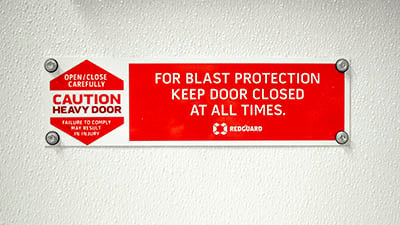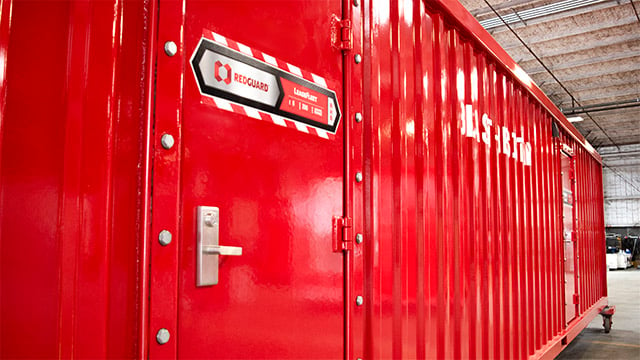We’ve written recently about the problems with blast-resistant buildings, and one problem that we hear about sometimes has to do with blast-resistant doors. Blast-resistant doors are made of steel and weigh-in at around 450 pounds. That’s a lot of weight for a door, considering the average solid-core door on a home weighs well under 100 pounds.
 But unlike a traditional door, the door on a blast-resistant building (BRB) is made to resist the significant force of a blast wave. A BRB is only as strong as its weakest component, a factor known as a single degree of freedom.
But unlike a traditional door, the door on a blast-resistant building (BRB) is made to resist the significant force of a blast wave. A BRB is only as strong as its weakest component, a factor known as a single degree of freedom.
Being rugged and protective is crucial since even a blast wave with pressure as low as 5 psi can cause significant damage to the human body. That makes the weight of the door less of a problem, and more a factor that makes the building safe.
Also, unlike a traditional door, a blast-resistant door requires a little bit of maintenance and more attention than the door on your average home. To keep work areas safe, some steps need to be followed.
Don’t leave blast-resistant doors open
As tempting as it may seem, blast-resistant doors should never be left propped open to make entering and exiting the building more manageable. Propping the blast-resistant door open effectively removes the building’s blast-resistance, because it allows the blast wave to make contact with the inside of the building when it usually would pass over.
Regular maintenance for blast-resistant doors
The door on a blast-resistant building is one of the elements that require occasional maintenance. Because of their weight, the doors are subject to sagging if regular maintenance is not performed.
Sagging means the hinges or latches can come out of alignment, causing the door not to seal correctly, so the door literally sags in a way that it no longer fits into the door frame. Going back to the term “single degree of freedom," mentioned above, a door that no longer fits or closes properly can have a negative effect on the building’s overall blast resistance.
 Maintenance to watch for this issue should be done every 60 days. During maintenance, hinges, latches, and fasteners should be visually inspected, tightened when necessary, and worn hardware should be replaced.
Maintenance to watch for this issue should be done every 60 days. During maintenance, hinges, latches, and fasteners should be visually inspected, tightened when necessary, and worn hardware should be replaced.
During this maintenance, another component that should be checked is the fluid in the hydraulic mechanism, sometimes called the arm, located at the top of the door. This is the piece that prevents the door from slamming and makes it easier to open and close.
In areas where the air temperature can fluctuate, or if the door is already slamming, a technician will check the viscosity of the fluid to make sure it’s in the correct state. A door that is likely to slam could easily injure a hand or foot caught in the door.
Maintenance on a blast-resistant door: DIY or service plan?
You may decide to take on this maintenance task yourself, and that’s perfectly okay! It’s a good practice to find out from the manufacturer of your blast-resistant building what factors need to be checked and at what intervals.
They may be able to provide you with a maintenance document or helpful checklist to guide you through the components to check on doors and other building parts. Once you know, then make sure you follow through or delegate it to someone who will.
On the other hand, if you want to make sure maintenance is done right without the worry of missing details, or if you simply don’t have the time every 60 days to devout, it’s worth checking to see if your BRB provider has a full-service option. If you land more in the latter scenario, there’s probably a service plan or maybe even a warranty service plan that could help you.
A reputable manufacturer of blast-resistant buildings should have an end-to-end warranty that covers problems and service plans that cover everything in-between, including regular service. Sometimes blast-resistant building suppliers will even provide service on buildings that they didn’t sell you. It’s worth checking into.
The key is finding the maintenance plan that works for you.
issues with blast-resistant doors: Final Words
While blast-resistant doors may be substantial in weight, it’s important to know that a lot of research and engineering has gone into their design. It’s essential to use them in the way the manufacturer intended. When that rule is followed, along with all necessary maintenance, blast-resistant doors are really not a problem, but a life-saving part of a blast-resistant building.
The professionals on the RedGuard service team are leaders in the industry and take more than 1,000 service calls a year. Contact our service department If you’re thinking of a service plan for your blast-resistant buildings or just want to find out more about the services we provide.
Carreen Gibbons
Carreen Gibbons is the Communications Specialist at RedGuard. With a natural curiosity toward technical subjects and a love of learning new things, she writes content for the SiteBox Storage and RedGuard websites and spends her days learning new things about the industries that the companies serve.




